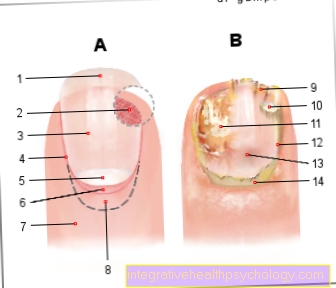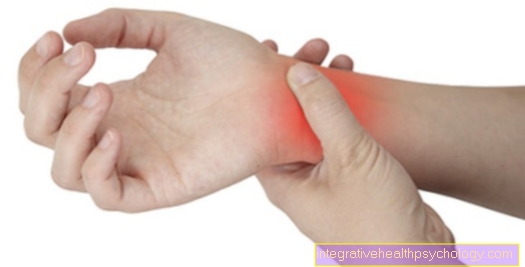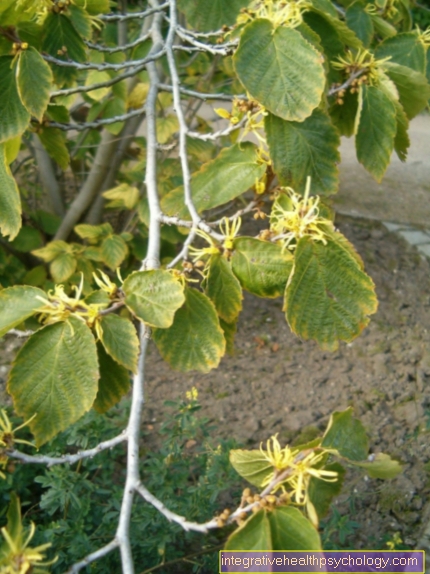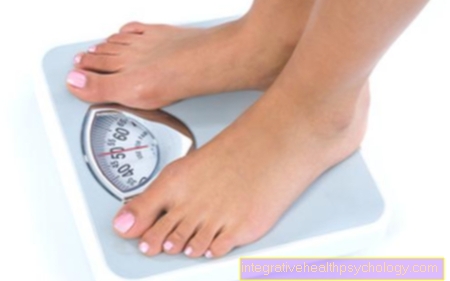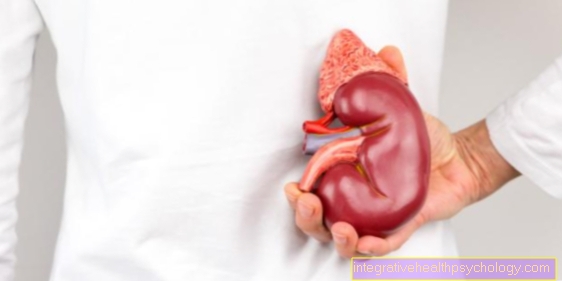Pain in the ring finger
definition
Ring finger pain can indicate numerous harmless or serious problems. All of the smaller movements in everyday life put a strain on the fingers. If a finger hurts, every move suddenly becomes a torture. The pain can appear dull and throbbing or be sharp and shooting with every movement. Extreme pain or latent pain over a period of weeks should urgently be clarified by a doctor, as in rare cases an unpleasant chronic condition can develop from this.

causes
In most cases, ring finger pain is caused by damage to the bones, muscles, tendons, joints and cartilage of the finger. In the vast majority of cases, there are harmless bruises or strains of the muscles and tendons that occur in every person in the course of life. Even more serious damage can result from injuries in everyday life or sports. For example, the fragile finger bones can break, extensor or flexor tendons tear, or joint cartilage can be damaged.
Many of the complaints in the finger start from the finger joints. Over time, the joints can wear out, so that osteoarthritis develops. This leads to cartilage wear and, after a while, the joint-forming bones rubbing against one another. Elderly people are particularly affected. Other causes of joint pain can be infections caused by pathogens, rheumatic inflammation or a gout attack.
Read more on the topic: Sore finger joints- these are the causes
Heberden osteoarthritis
Heberden osteoarthritis is a typical clinical picture of older people on the fingers. Without a recognizable cause, it comes in the end joints of the fingers, near the fingertips, to progressive cartilage wear and osteoarthritis. Typically there is painful inflammation in several fingers and the formation of so-called "heberden knots" on the extensor sides of the finger joints. The disease can be slowed down in the early stages with anti-inflammatory agents and physiotherapeutic measures. However, in order to maintain pain-free mobility in the finger in the long term, it is often necessary to stiffen the affected finger joint.
Read more on the subject at: Heberden osteoarthritis
Bouchard osteoarthritis
Bouchard osteoarthritis, on the other hand, is arthrosis of the middle finger joints. Like Heberden osteoarthritis, it appears to have no cause, but a hereditary predisposition is likely. Due to the progressive wear and tear of the cartilage, the bones of the joint rub painfully against each other after a while. As a result, bony attachments can form on the joint. In addition, the joint becomes unstable, movements are restricted and the position of the fingers can deviate so that the fingers are crooked. Treatment is often not necessary as the pain will subside on its own. In addition, the finger can be taped or splinted to counteract misalignments.
This article might also interest you: Finger osteoarthritis
gout
Gout is a metabolic disease that can cause significant pain in the ring finger. With the disease, the uric acid levels in the blood are significantly increased. This can be due to reduced uric acid excretion via the kidneys or an extremely increased intake through the consumption of alcohol, meat, legumes and numerous other foods.
After a while, the increased uric acid in the blood can form uric acid crystals, which form prematurely in the toe and finger joints and can cause attack-like pain. This creates a very painful inflammation at the affected joint. In the long term, uric acid levels can be controlled by changing your diet or taking a drug to break down uric acid.
Find out more about the topic: gout
Concomitant symptoms
The main symptom of all diseases and injuries to the ring finger is pain. This can vary in strength, stinging, throbbing, dull or movement-dependent. The nature of the pain already provides clues as to the underlying cause. Due to the pain, but also in the case of injuries to the bones, joints and tendons, the fingers are restricted in movement.
In addition, the fingers can be red, swollen and overheated, which indicates an active inflammatory process. The fingers can also visibly swell and become thick on the outside due to bone extensions or rheumatic nodules. In the long term, protracted illnesses can lead to stiffness and weakness of the fingers.
swelling
With swelling, there is an increased accumulation of fluid in the tissue. This can be increased synovial fluid, purulent inflammatory secretions or bloody effusions. The former speak for an inflammatory process, as it can occur with mechanical irritation of the fingers, with rheumatic diseases but also with osteoarthritis.
Bloody effusions are more likely to indicate an acute injury with damage to bones, muscles or tendons. The swelling can contribute to the pain and restricted mobility and thus exacerbate the symptoms. In order to prevent swelling, the finger should be cooled, elevated, compressed and immobilized after injuries or acute inflammation. This can reduce bruising and inflammation.
Read more on the topic: Joint swelling on the finger
Pain when moving
Movement-dependent pain is typical in diseases of the finger. Both direct diseases of the musculoskeletal system and inflammation of the tissue on the finger can lead to movement-dependent pain. The bones, joints and tendons are involved in flexion or extension in the finger.
In particular, bone damage after injuries or advanced osteoarthritis can make the movement painful. If the cartilage of the finger joint has completely disappeared, the neighboring bones rub against each other with every movement, which can cause considerable pain.
diagnosis
Many of the diseases of the finger are so-called "eye diagnoses". This means that by describing the symptoms and the clinical picture and inspecting the finger, a reliable diagnosis can be made. This is the case with fractures and significant injuries to the finger, but also, for example, with Heberden osteoarthritis.
The examination of the finger can be followed by an ultrasound examination and an X-ray. The ultrasound examination allows conclusions to be drawn about swelling and fluid accumulation in the tissue. In addition, experienced doctors can also detect tendon and cartilage damage using ultrasound. The bony structures can be examined more closely in the subsequent X-ray image. Osteoarthritis can already be recognized by a narrowing of the joint space and other signs. An additional MRT examination can be carried out in order to then display the soft tissue in high resolution and more precisely. However, this is only done as a supplementary diagnosis if there are further uncertainties.
therapy
Treatment for ring finger pain varies widely with the underlying cause. Many of the symptoms are temporary and only need to be rested and immobilized for a few weeks. Torn tendons are often only treated conservatively by splinting the finger. Even with the first signs of arthritic changes in the finger, drug therapy is initially carried out while protecting the finger. For this, pain relievers and anti-inflammatory agents can be taken.
Cortisone can also be injected into the finger joint, which calms inflammation and can temporarily stop the progression of osteoarthritis. Advanced traumatic or degenerative damage to the ring finger may have to be treated surgically. For example, breaks often require surgical screwing to ensure stability. Surgical therapy for osteoarthritis of the finger, on the other hand, often consists of stiffening the affected joint. Although the mobility of the joint is reduced, the pain-free mobility of the rest of the finger is made possible again.
Find out more about the topic: Treatment of finger osteoarthritis
Duration
The duration of the pain in the ring finger cannot be determined across the board. Depending on the severity of the illness or injury to the finger, the pain can subside after a few days to weeks. A follow-up treatment of around 6 weeks can also be expected after surgical therapy. The pain usually subsides during this period. Chronic wear and tear diseases such as Heberden or Bouchard osteoarthritis can cause pain over long periods of time. Even if the symptoms can be treated with medication, a chronic course of months or years can often be expected.
Pain in the metatarsophalangeal joint of the ring finger
The metacarpophalangeal joint of the ring finger is located between the metacarpal bone and the part of the finger that is close to the body. This area, which is often referred to as the “ankle”, can be particularly affected by acute injuries but also by degenerative diseases. The metacarpal bone of the ring finger can be bruised and broken from blows or falls. The pain is projected onto the back of the hand rather than the ring finger.
If this bone is broken, surgical splinting is often necessary to maintain the stability of the hand and ring finger. Arthrosis and wear and tear on the cartilage are also often found on the metatarsophalangeal joint of the ring finger. In the course of its life it is exposed to some stresses, as a result of which the wear and tear in this area progresses faster. Rheumatoid arthritis is a disease that typically affects the metatarsophalangeal joint of the ring finger. The common rheumatic disease particularly affects the base joints of the fingers and leads to painful inflammation, restricted mobility and stiffness.
Also read the article on the topic: Therapy for rheumatoid arthritis
Pain in the middle ring finger joint
The middle joints of the ring finger are less affected by pain than other joints of the finger. Due to their exposed location, they too can often be affected by injuries from falls or blows with the fist. In the course of life, signs of wear and tear of the cartilage can develop, which is known as Bouchard osteoarthritis. In addition to the metatarsophalangeal joints of the ring finger, the middle joints can also be affected by the inflammation in rheumatoid arthritis.
Pain in the ring finger joint
The ring finger end joints are the smallest joints on the finger. They are exposed to less stress and rarely affected, even with rheumatic inflammation. Nevertheless, osteoarthritis often develops in the small ring finger end joints in old age. For apparently inexplicable reasons, the so-called "Heberden osteoarthritis" occurs particularly in this row of joints.













